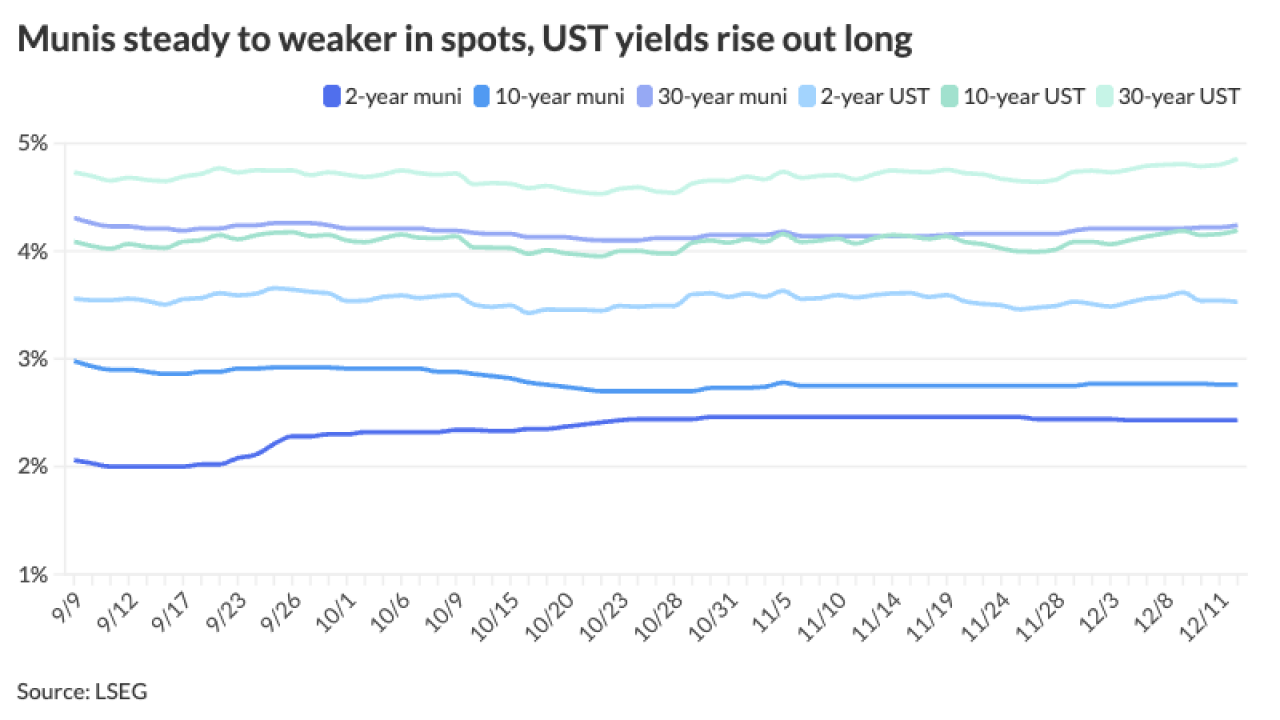
Pacific Investment Management Co.’s newest exchange-traded fund drags the active-versus-passive management debate into the taxable municipal bond space.
Earlier this week, the Newport Beach, Calif.-based money manager launched the PIMCO Build America Bond Strategy Fund, the third ETF devoted to BABs — the taxable municipal securities created last year under the American Recovery and Reinvestment Act.
Using the ticker symbol “BABZ,” the fund has accumulated $13 million in assets. The fund is managed by John Cummings, head of Pimco’s formidable municipal desk. Pimco manages $30 billion of municipal bonds, and has been the biggest institutional buyer of BABs.
Unlike the two existing BAB ETFs, this one will try to beat the market.
Pimco’s foray into the municipal ETF industry has drawn a line in the sand between the firm’s active management style and the passive style favored by other industry stalwarts — SPDR Nuveen, iShares, Van Eck Global, and Invesco PowerShares.
The active-passive debate runs as follows: Pimco believes it is capable of beating the market. The other complexes aren’t so sure.
“It’s always going to be a debatable topic,” said James Colby, senior municipal strategist at Van Eck Global, referring to the active-passive debate. “Maybe that debate needs another few years of seasoning.”
The first muni ETF — the iShares S&P National AMT-Free Municipal Bond Fund — came to market in September 2007.
Now with more than $2 billion in assets, the fund is passively managed, meaning its only goal is to mimic returns on the S&P National AMT-Free Municipal Bond Index. Other complexes followed with a plethora of ETF types, tracking benchmarks ranging from state-specific to variable-rate debt obligation to target maturity to insured indexes. All were passively managed.
Passively managed funds strive to replicate their indexes through a process known as representative sampling. This entails breaking an index down by characteristics — such as duration, credit risk, and maturity — and constructing a portfolio whose aggregate characteristics match those of the index being replicated.
Passive ETF managers worry not about delivering strong returns but about “tracking error,” which occurs when their returns become unmoored from the index being tracked.
Pimco’s first two municipal ETFs proposed trying to beat their benchmark indexes, rather than expending so much quantitative brainpower replicating them.
Grail McDonnell also launched an actively managed ETF in January, though it has only gathered $2.6 million in assets.
Of the 30 municipal bond ETFs in existence, four are active. Those four funds represent less than 1% of the industry’s $8.07 billion in assets.
Invesco PowerShares launched the first Build America Bond ETF in November, with a mandate to track the BofA Merrill Lynch Build America Bond Index. That fund now manages $542.3 million, and is the sixth-biggest muni ETF. SPDR Nuveen followed in May with a passive fund tracking the Barclays Capital Build America Bond Index, now with $26 million in assets.
The Pimco BABs fund also lists the Barclays Capital Build America Bond Index as a benchmark, though it treats it as a benchmark to beat rather than to match.
"We make specific credit decisions when we buy muni bonds," said Bob Fields, the product manager for the BABs fund. "If we’re making credit decisions, why not reflect those in our muni ETFs? To avoid credits that we think are weakening and to purchase credits we think are stable or strengthening."
The language in the respective ETF prospectuses highlights the difference in approach. The investment objective for the Pimco fund is “maximum income, consistent with preservation of capital,” whereas the PowerShares ETF “seeks investment results that correspond generally to the price and yield” of the target index.
The funds also emphasize different risks. While Pimco mainly focuses on credit risk, interest rate risk, and liquidity risk, the PowerShares prospectus lists “sampling risk” and “noncorrelation risk.” The SPDR Nuveen BABs fund cites “index tracking risk.”
If using expertise to beat an index rather than mimic it seems like an obvious choice, consider that it is more expensive. Active muni ETF managers based on a weighted average charge 0.37% in annual fees, compared with 0.25% for passive funds.
Pimco’s BAB ETF charges 0.45% of assets annually, compared with 0.35% for the passive PowerShares fund with the same benchmark index.
It is too early to declare winners in the debate.
As of the end of August Pimco’s intermediate-term ETF after fees had outperformed its benchmark, the Barclays Capital 1-15 Year Municipal Bond Index, since inception by 50 basis points.
This occurred during a practically uninterrupted bull market in municipal bonds, making it difficult to discern how the fund would fare through multiple cycles. Further, there is no passive fund tracking this index, so nobody knows whether a fund trying to replicate its returns would have fared any better.
The Pimco fund outperformed its index in the second quarter by nine basis points.
Further, passive ETFs do not always track their indexes perfectly. The iShares national fund underperfomed its target index by 160 basis points last year and outperformed it by 190 basis points.





